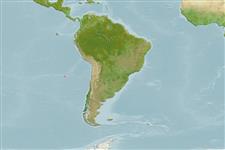>
Perciformes/Scorpaenoidei (Scorpionfishes) >
Plectrogeniidae (Stinger flatheads)
Etymology: Plectrogenium: Greek,plektron = anything to strike with, spur + Greek, geny, -yos = face (Ref. 45335); barsukovi: Named for V.V. Barsukov..
Environment: milieu / climate zone / depth range / distribution range
Ekologi
marina djupbottenlevande; djupintervall 290 - 310 m (Ref. 35728). Deep-water
Southeast Pacific: Nasca Ridge.
Size / Vikt / Age
Maturity: Lm ? range ? - ? cm
Max length : 5.2 cm SL (female)
Short description
Morfologi | Morfometri
Taggstrålar i ryggfenan (totalt): 12; Mjukstrålar i ryggfenan (totalt): 7; Taggstrålar i analfenan 3; Mjukstrålar i analfenan: 5; Ryggkotor: 25 - 27. Body slim, with greatest depth 4.4-4.5 times SL. Soft dorsal fin with a large dark spot. Interorbital space narrow, 5.6-6.1 times HL; with long nuchal spines (25-28% of the horizontal diameter of the orbit) (Ref. 35728).
Life cycle and mating behavior
Könsmognad | Reproduktion | Lek | Ägg | Fecundity | Larver
Mandrytsa, S.A., 1992. The new species and new records of fishes from the genera Phenacoscorpius and Plectrogenium in the Pacific, Atlantic and Indian Oceans. J. Ichthyol. (7):100-109. (Ref. 35728)
IUCN Red List Status (Ref. 130435)
Human uses
Fiskeri: saknar intresse
Ytterligare information
PopulärnamnsynonymerMetabolikPredatorerEkotoxikologiReproduktionKönsmognadLekSpawning aggregationFecundityÄggEgg development
Age/SizeTillväxtLength-weightLength-lengthLength-frequenciesMorfometriMorfologiLarverLarvdynamikRekryteringAbundansBRUVS
referenserVattenbrukVattenbruksprofilAvelslinjerGenetikElectrophoresesÄrftlighetSjukdomarBehandlingNutrientsMass conversion
MedarbetareBilderStamps, Coins Misc.LjudCiguateraHastighetSimsättGälytaOtolithsHjärnstorlekSyn
Verktyg
Special reports
Download XML
Internet-källor
Estimates based on models
Preferred temperature (Ref.
123201): 10.9 - 11.2, mean 11 °C (based on 5 cells).
Phylogenetic diversity index (Ref.
82804): PD
50 = 1.0000 [Uniqueness, from 0.5 = low to 2.0 = high].
Bayesian length-weight: a=0.00389 (0.00180 - 0.00842), b=3.12 (2.94 - 3.30), in cm total length, based on all LWR estimates for this body shape (Ref.
93245).
Trofisk nivå (Ref.
69278): 3.3 ±0.5 se; based on size and trophs of closest relatives
Resiliens (Ref.
120179): Mellan, lägsta populationsfördubblingstid 1,4-4,4 år (Assuming tmax>3).
Fishing Vulnerability (Ref.
59153): Low vulnerability (10 of 100).
